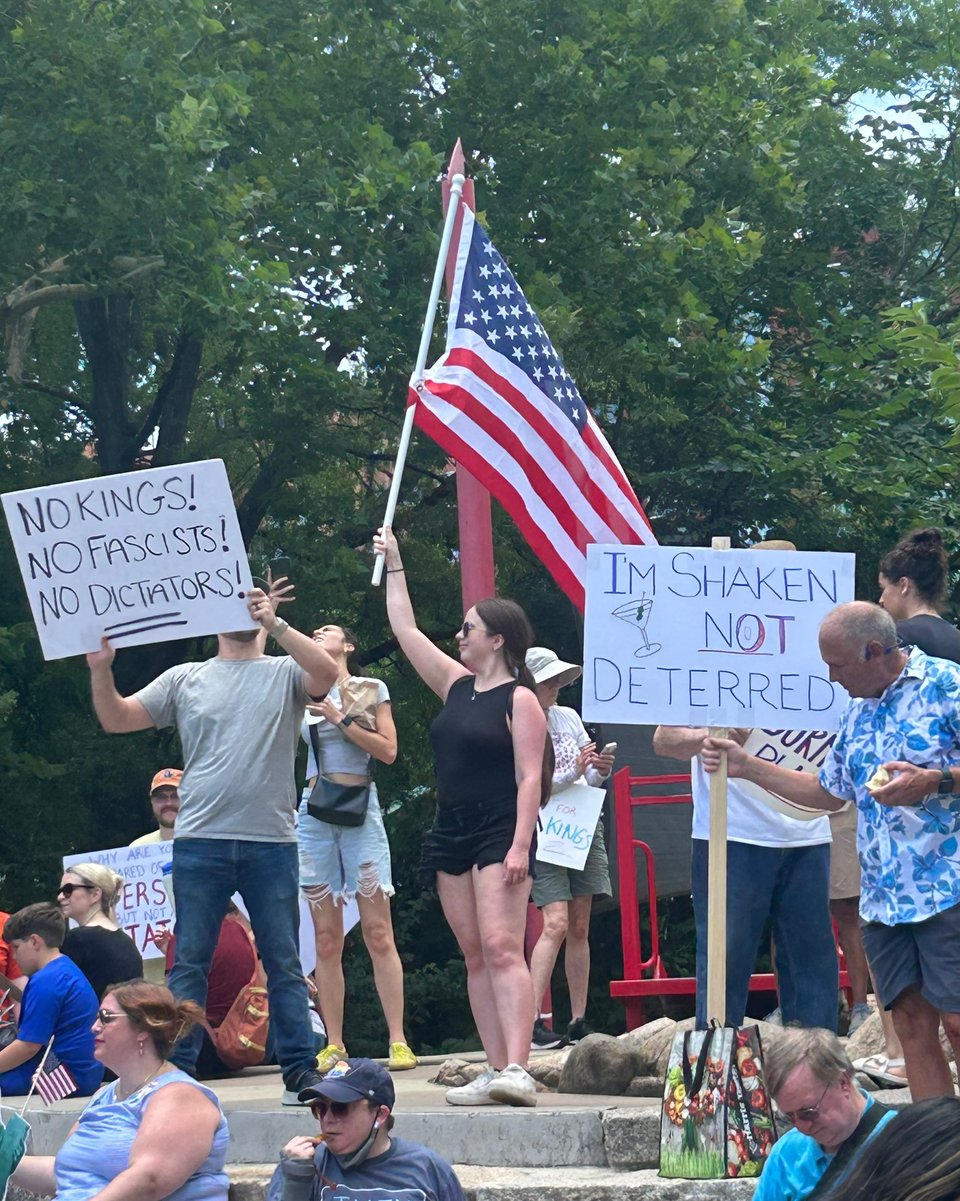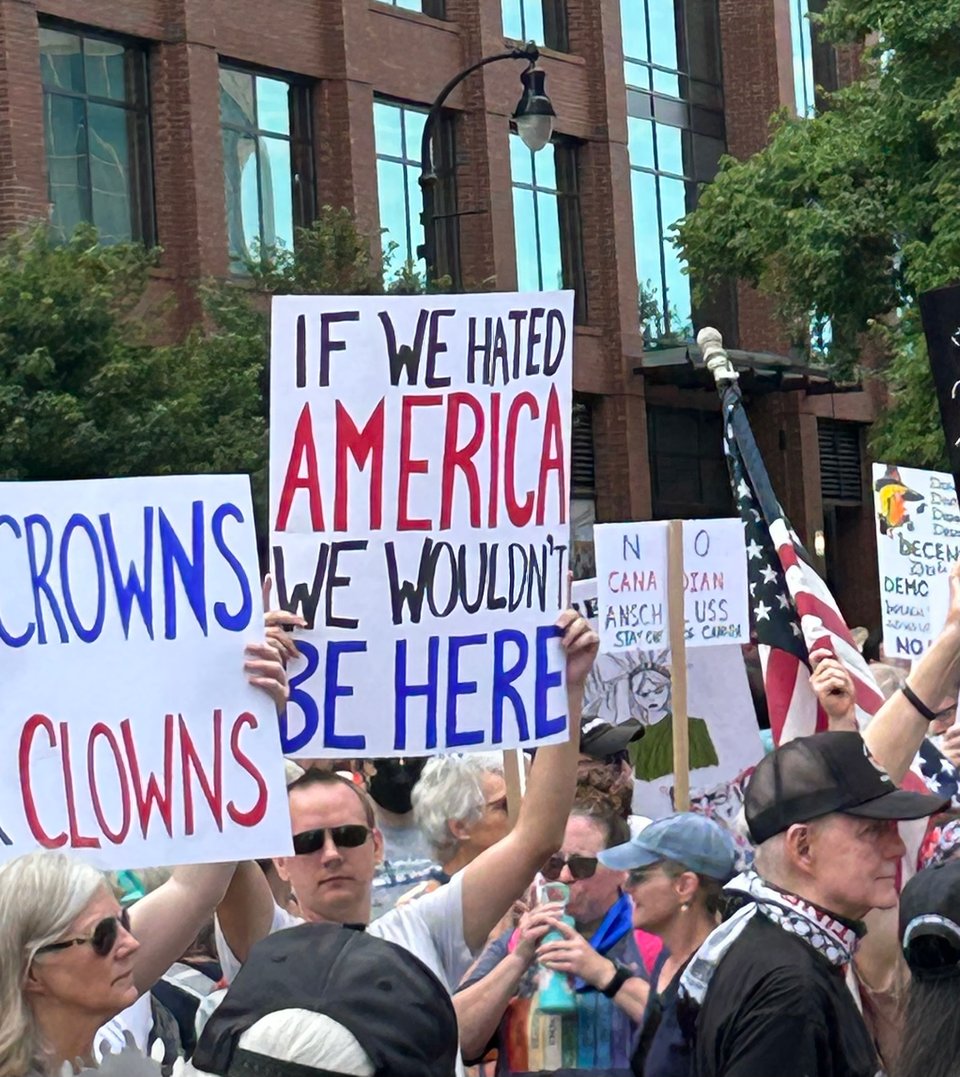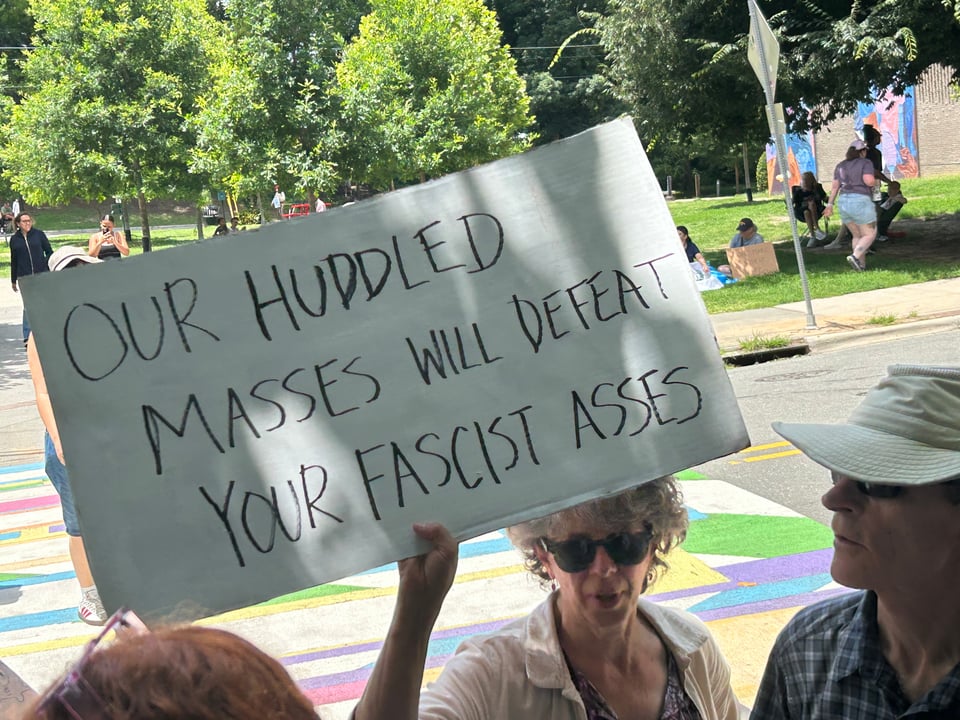Capture the Flag?: Keeping ScOR #9
June 26, 2025
At the “No Kings” protest in my town, Durham, North Carolina, two things got my attention. First, the turnout. Compared with another anti-Trump protest in April, this crowd was several times larger. In a small city of 300,000, roughly 5,000 came out on that sticky June day. It was Durham’s contribution to a national total estimated at 5 million, which made “No Kings” possibly the largest single-day protest in U.S. history.

The second striking thing? The flags. So many American flags! Everywhere you looked someone was brandishing one, as small as a leaflet or as large as a bedsheet. At previous protests, flags were few and far between.
The Stars and Stripes flew at the June 14 protests for several reasons. It happened to be Flag Day – usually a low-key commemoration of the date in 1777 when the Continental Congress established the original U.S. flag. More important, this day of action was a direct response to the military parade in Washington, D.C., which Trump had ordered up to mark the 250th anniversary of the U.S. Army – and which also fell on his 79th birthday. Displays of tanks and marching soldiers in the streets of the capital are usually more of a Russian or North Korean thing – though Trump claimed to have been inspired by a Bastille Day display he witnessed in Paris. Regardless, the parade typified Trump’s embrace of the most superficial and jingoistic patriotic symbols. (He likes to make a show of literally hugging and kissing the flag.) So, protest organizers had encouraged marchers to bring flags, and in some places even handed them out. “The flag doesn’t belong to Donald Trump,” the No Kings website said. “It belongs to us.”
It’s absurd to talk of Trump’s opponents as the ones who need to “reclaim” patriotism.
This moment felt like an intriguing plot twist in the long struggle over the meaning of patriotism in America – a tug-of-war that the right has typically dominated. Those of us to the left of center, or otherwise suspicious of flag-waving nationalism, have often ceded the field to the right, allowing conservatives to claim the mantle of traditional patriotism – while choosing instead to focus on universal values like justice, human rights, and equal opportunity. But Trumpism in its 2025 edition seems determined to hand the flag back to its opponents. Trump’s blatantly anti-democratic actions have served to clarify and crystalize an understanding of American patriotism that even some Radical Left Lunatics™ can get behind.
*
In the days before his big parade, Trump was asked about the prospect that protesters might show up in DC. Any who did, he warned, would be “met with very heavy force.” He added, “This is people that hate our country.”
At least one guy at the protest in Durham carried a sign with a direct rejoinder: “IF WE HATED AMERICA WE WOULDN’T BE HERE.”
I’m old enough to remember the 1970s bumper stickers with the prominent image of the flag and the slogan, “America: Love It or Leave It.” Aimed at Vietnam War protesters, the message was clear: Criticism of your government, especially in wartime, is all but treasonous. The reply came in phrases like, “Dissent is the highest form of patriotism.” (This line is often misattributed to Thomas Jefferson. There’s no evidence he ever wrote or said it.)

Love of country can take a million individual forms, but in the United States, patriotism seems to come in two broad models – which tend to align, of course, with the two sides of our political divide. These competing frameworks draw on very different notions of what we should celebrate as Americans – on what, if anything, makes the U.S. “exceptional.”
For many, it’s the nation’s might and its general “greatest country in the world”-ness, based mainly on the strength of our military and economy. Let’s call this the USA! brand of patriotism. (Think of those bellicose “U-S-A!! U-S-A!!” chants that some folks like to launch into for just about any reason at all.) This brand of national pride often includes an unquestioned belief that only Americans are truly free — in fact, that our forebears pretty much invented freedom. (Those who believe this could inquire with, for example, the Indigenous people who were here when Europeans arrived, most of whom lived in much more democratic communities, with greater personal freedom, than citizens of the U.S. enjoy to this day.)
The second model we could call Movement patriotism. It’s grounded in the conviction that this country is great – or, more to the point, good – precisely to the extent that people have fought to make it so. Folks have indeed struggled, by necessity, to make America more just, more equal, more small-d democratic. I’m talking about the U.S.A. of Frederick Douglass and Harriet Tubman, Ida B. Wells and Mother Jones, Cesar Chavez, Martin Luther King, Jr., Winona LaDuke....
Does it make sense to claim heroic dissidents like these as a source of national pride, to even call this Movement model “patriotism”? It’s a fair question. As my collaborator Chenjerai Kumanyika said in our Seeing White season, these people were often fighting to survive despite America. They were resisting America, as it was shaped by its architects and those who’ve usually run things around here. Which makes it rather rich, arguably, to turn around and embrace these fighters as great or emblematic Americans.
Appealing to the Revolutionary generation for the moral high ground can be risky, given the founders’ profound hypocrisies.
At the same time, this country’s social justice advocates have often made an implicitly patriotic appeal. They’ve cited the nation’s claims about its ideals, such as “all men are created equal.” Americans like to boast that ours is a country founded not on blood and soil but on a set of ideas — with self-government at their core. To a lot of us, this is what American Exceptionalism means if it means anything at all. Those who’ve labored to make the U.S. better have often demanded that it be the country it says it is.
Some marchers on June 14 were making the same demand, carrying signs with slogans like “NO KINGS SINCE 1776.”
Appealing to the Revolutionary generation for the moral high ground can be risky, given the founders’ profound hypocrisies. It doesn’t really work to say, “Racism? Patriarchy? Oligarchy? These are un-American! The founders would revolve in their graves!” As we’ve pointed out on the podcast, most of the prominent founders were not committed democrats by our standards.
But “no kings” stands up pretty well. The founders threw out the monarchy. They wrote the Bill of Rights, checking the government’s power in order to guarantee individual liberty. In debating the Articles of the Constitution, the framers considered at length the danger that a future executive could seek to become a tyrannical ruler. They designed a three-branch structure aimed at preventing just that. Constitutional scholars routinely say Donald Trump is exactly the kind of demagogue the founders feared.
*

The Democratic Party has tried, usually ham-handedly, to reclaim patriotism in the face of the GOP’s perceived monopoly. At the 2024 National Convention that nominated Kamala Harris, the Dems made “freedom” a central slogan, and at Hillary Clinton’s 2016 convention they filled the hall with flags and featured military leaders as speakers. Who can forget John Kerry, the Vietnam War hero, and that cringey line in his 2004 nomination speech, accompanied by a salute: “I’m John Kerry, and I’m reporting for duty.”
These attempts fell flat. You can’t out-patriot the GOP with the flag and military glory. The left, broadly construed, won’t draw conservative voters to its side by adopting the tropes of USA! patriotism and saying, “We’re into this stuff too, sorta!”
But Trump 2.0 may be shifting the landscape. The President’s military parade was an anticlimactic dud; independent estimates put the turnout in DC in the tens of thousands. Millions instead flocked to “No Kings” protests and many carried flags. Opinion polls in the following days, including from Fox News, found more Americans turning against Trump — especially on immigration, which had been his strongest issue. Those surveys were taken in the wake of the administration’s stepped-up ICE raids in Los Angeles, which drew local protests followed by Trump’s inflammatory decision to federalize the California National Guard and send in Marines. His aggressive and possibly illegal foray into Los Angeles looks unpopular so far. You wouldn’t know it from the media coverage, but far more Americans are joining protests against Trump in 2025 than did in the first year of his first term.
*
What is patriotic in the United States in the 2020s? The demonization of a free press? A conspiracy to overturn a settled election? Virulent nativism – in a country that long pointed to the Statue of Liberty as a core symbol of its values and history? Government by executive fiat — Congress, courts, and rule of law be damned?
Or an insistence on the Constitutional rights of every person (see the Fifth Amendment: “No person shall ... be deprived of life, liberty, or property, without due process of law.”) and an adherence to limits on the president’s power?
Let’s be clear: It’s absurd to talk of Trump’s opponents as the ones who need to “reclaim” patriotism.

Trump has defied political gravity for so long that it’s tempting to think he always will. Those of us who see clearly that he’s an aspiring despot have gnashed our teeth for years as roughly half our fellow citizens either cheer him on — he’d be their despot, after all — or somehow fail to see what we see. Maybe, just maybe, one of these days, Trumpism’s frontal assault on some of the best parts of the American experiment will finally sink in among a decisive majority.
If waving the flag can help even a little in this fight, if people want to express their opposition and their anger by waving the Stars and Stripes, that’s just fine with me. In this historical moment, the flag doesn’t have to signify “U-S-A! U-S-A!” It can say, simply: No kings.
-
Bravo, John!
-
Thanks, John, for capturing the spirit of the "No Kings" rallies and the many ways to express a commitment to country, constitution, and to the rights of common people. I love the many signs you document and interpret as part of your piece. Keep up the good work!
-
Love the "Capture the Flag" title! I carried the American flag at Portland’s No Kings rally. I carried it as the symbol of our All-American movement, remembering how “they” carried the Confederate Stars & Bars through the Capitol Rotunda on January 6th. And the Nazi Swastika through the streets of Charlottesville. And the “Don’t Tread on Me” coiled snake flag at maga rallies. I say let them have their flags of trump and treason. The American flag belongs to all of us. Democrats, Independents, Republicans. But not to those who would do harm to America or to Americans. At the rally I saw so many signs with terrific messages: “Human Need before Corporate Greed”, "Make America Moral Again”, A Better World is Possible”, "IKEA has Better Cabinets”, “Does This Ass Make My Country Look Smaller?”. By waving the Stars & Stripes — right-side-up — my message was, “We love our country, and this is our flag,” a symbol of resistence and renewal.

Add a comment: